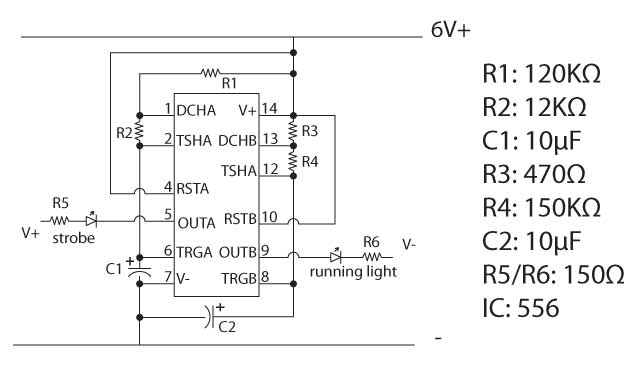LED test circuit NOT bright..where did I go wrong ?
Hi,
This is a test circuit I have followed to make two lights flash at different rates.
They will be used in a Star Trek model.
Attachment not found.
The test works and they flash....BUT hopelessly dim..
If anyone can tell me where I have gone wrong I would appreciate it.
Also I would like to add I`m really enjoying learning about electronics , however not
finding my brain power up to speed in this area..any help would be great.
I should add I`m using a 9v battery...and my capacitors are 10uf as specified but 10uf 100v
Thankyou, regards Kevin T.
This is a test circuit I have followed to make two lights flash at different rates.
They will be used in a Star Trek model.
Attachment not found.

The test works and they flash....BUT hopelessly dim..
If anyone can tell me where I have gone wrong I would appreciate it.
Also I would like to add I`m really enjoying learning about electronics , however not
finding my brain power up to speed in this area..any help would be great.
I should add I`m using a 9v battery...and my capacitors are 10uf as specified but 10uf 100v
Thankyou, regards Kevin T.


Comments
Charge time 0.693(R1 + R2)*C -> 0.91s
Discharge time 0.693(R2)*C -> 0.08s
Charge time 0.693(R3 + R4)*C -> 1.04s
Discharge time 0.693(R4)*C -> 1.04s
Thanks for your reply..sadly as a novice I dont understand what I need to do to make the LED brighter...whilst maintaining the flashing sequence I have for the project
Good question PJ.
Moved to General Discussion.
1. Whose '556 are you using? Not all are created equal, and some have more output drive than others, particularly on the high side.
2. It's possible that you've selected LEDs that just aren't bright. What happens when you connect one to 6V with the 150R resistor? Is it still dim?
-Phil
thankyou for your replys.
Following on from The Dr's advice I have tested the battery and tried another.
However when I tried just a 150 or 120 resistor across the battery it was still just as dim,and
when I tried a 1k resistor it was as bright as I would like .. so I guess I need a lower resistor.
The maths of which though is just beyond me..
-Phil
When you say V+ and V- are you saying that there are other voltages besides the 6V? Could it be that you have cooked the LEDs because it sounds either that the 150R resistors are 15R or else they are 150K. Methinks a photo is in order.
TIp: Never say V- when it is in fact the common reference rail from which the supply voltage is measured from. A V- infers that there is also a voltage that is more negative than your common and likewise V+.. Also write 6V+ simply as +6V as that is the nominal voltage. So the LEDs could easily have been drawn with a wire going to common and one to +6V, no more confusion.
BTW, post#4 is very confusing as you say "when I tried a 1k resistor it was as bright as I would like" or did you mean wasn't as bright?
Hi Phil,
I placed a resistor between the LED and battery and then lit it from there.
-Phil
My receipt for the resistors states..150k....now I see that R5 and R6 just says 150 and R3 470.
I bought 150k and 470k.
This must be where I've gone wrong..?
Yup.
-Phil
kt2050 - is this issue solved? If so, it would be good to mark the original post as "solved" so other readers know.
Hardly worth going back to the store for a refund or return on 10 resistors, but a nightmare if you don't check the value with a multimeter as you build.
I have a nice big pile of 10 megaohm resistors that were sold to me as 10 K ohm. next to useless <sigh>
At least with 150K and 470K, you might someday find something to use them for (an op amp project).
A visit to Maplins this morning and with correct resistors fitted the LEDs are as bright as
I wanted..something learned...many thanks to all.
Hi...its the Polar Lights Enterprise refit...but the small 1/1000 ...my plan is to use a mix of LEDs and fibre optics.
Progress is steady...but for me...functioning within normal parameters..